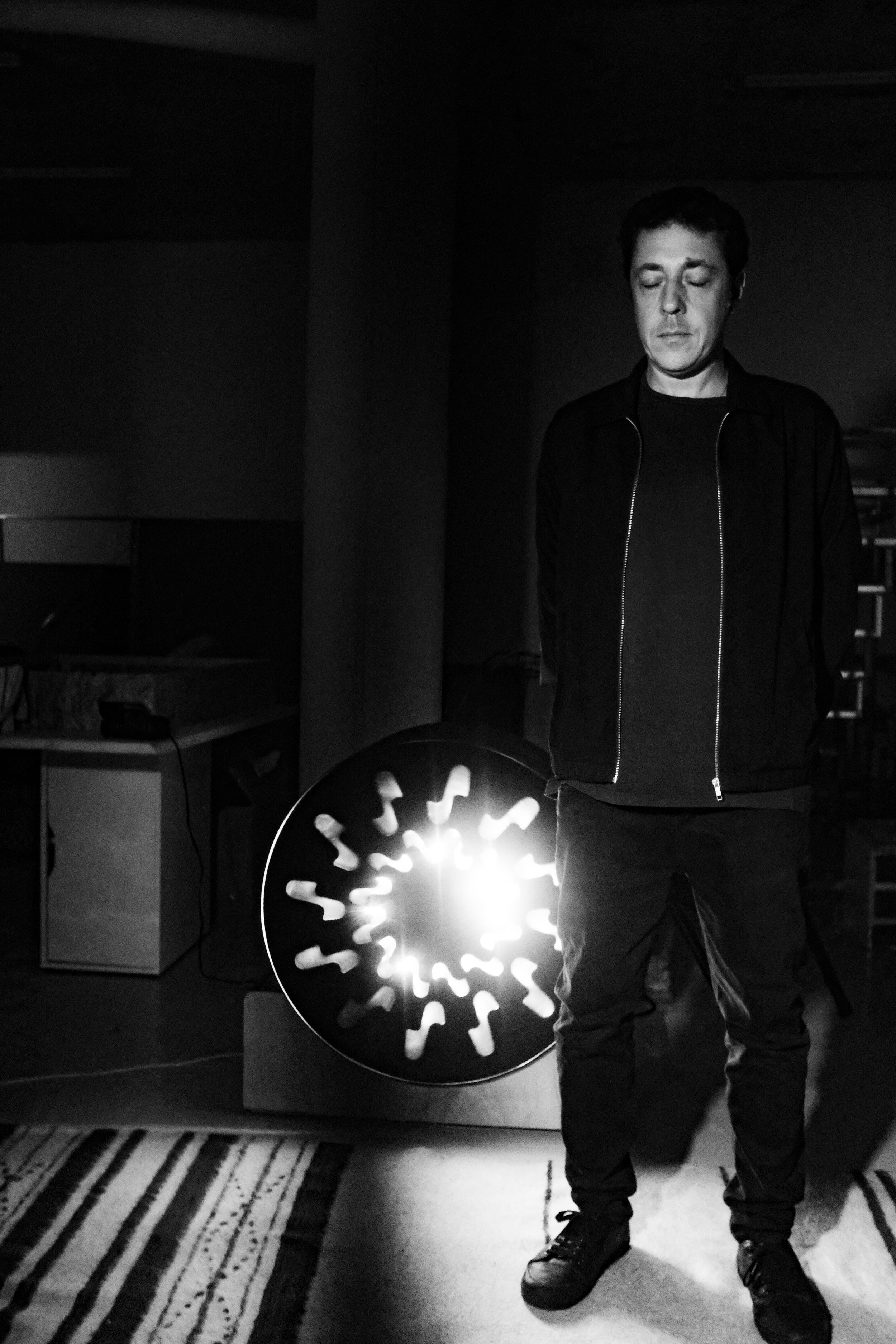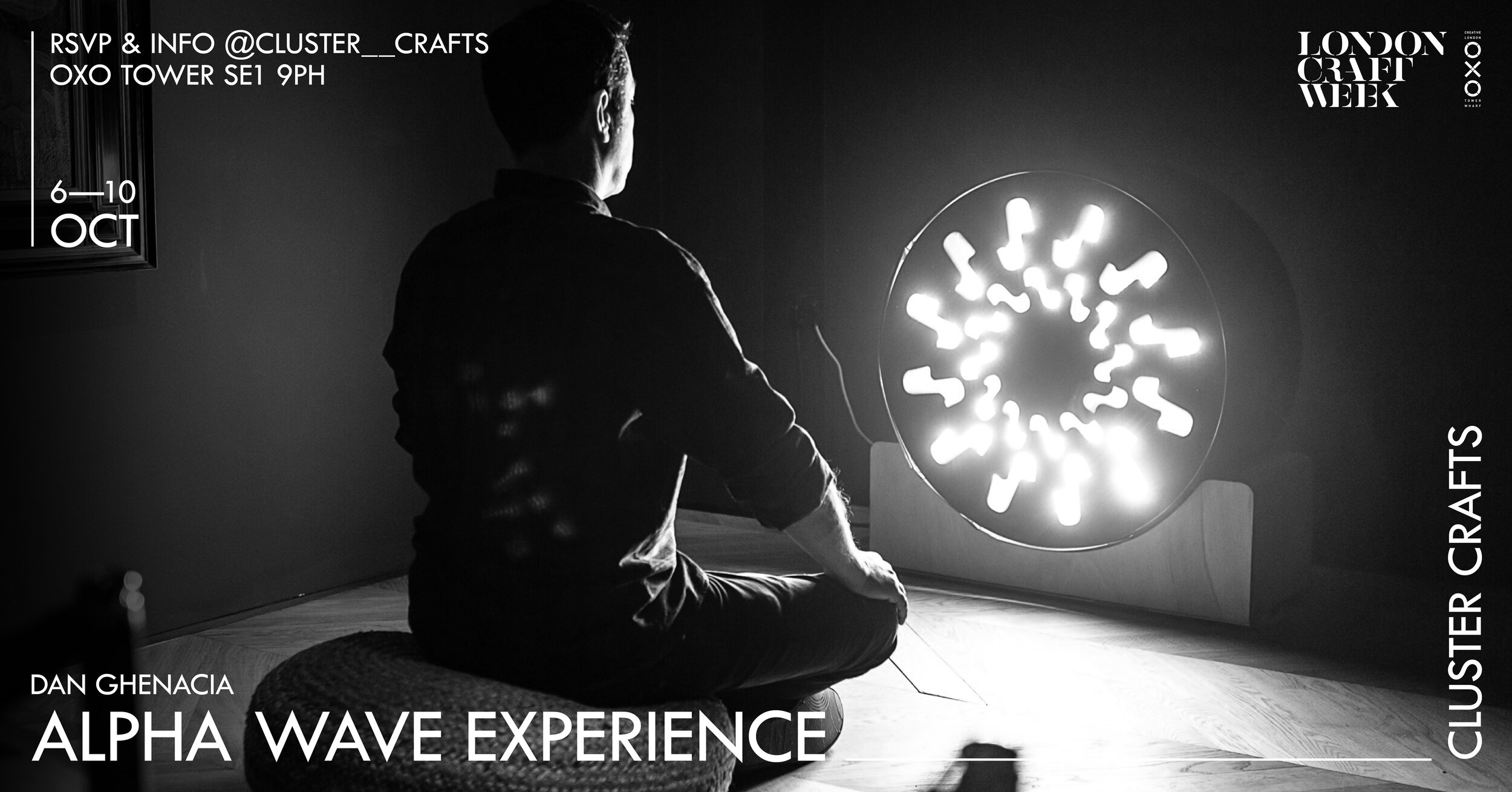DAN GHENACIA
On 21 December 1958, the artist Brion Gysin was travelling by bus through the verdant expanse of rural France. As the sun began to set behind a long avenue of trees, he closed his eyes, only to experience the stir of psychic revolution swirling on behind his eyelids; a transcendental storm of colour visions and luminous patterns. In his journals from the time, he describes the event as a “multidimensional kaleidoscope whirling out through space. I was swept out of time. I was out in a world of infinite numbers.” It was here where he first conceived of The Dream Machine, a pioneering piece of hallucinatory kinetic art that employs rapid light movement to affect human consciousness.
It was, Gysin claimed, “the first art object to be seen with eyes closed.” Now, more than half a century later, the artist/musician DAN GHENACIA has recreated the Dream Machine for the 21st century. The result is the Alpha Wave Experience, a multi-dimensional sensory experience, transporting audiences deep within their consciousness to a space where dreams and reality collide. In collaboration with Cluster, Ghenacia will be taking over a room of the Oxo Tower this October, bringing the piece full circle, back to the city where it was first exhibited in 2020.
Alpha Wave Experience
Photos by Aurelien Caoudal
Supporting Cluster Craft’s vision for the future, this exhibition is part of the launch of Soil, Surface, Sky, a Cluster publication augmenting the traditional exhibition format through the use of QR codes, prompting three-dimensional renders of featured artists' work. Ahead of The Alpha Wave Experience, we caught up with Dan to talk about process, collaboration, and the importance of reflection in a post-covid world.
Photos by Aurelien Caoudal
Firstly, can you tell us a bit about yourself and your background?
I’ve been DJing solo for 20 years, and as a group with Apollonia. My passion has always lied with music and everything it involves: lights, visuals, concept creation, but most importantly, the ‘human’ side of music – bringing people together.
I’m also passionate about visual art, from classic to contemporary. It runs in the family, as my father runs an art gallery in Paris (Sobering Galerie) and this definitely influenced the way I create and appreciate music. Before I was living between Paris and Ibiza, but since 2018, I’ve been based in Lisbon.
The Machine has an interesting back story involving the artist Bryon Gysin. How did you first encounter this and what inspired you to recreate it?
In 2014, I was hunting ideas for the visual aspect of Apollonia’s shows. I googled some keywords - turntable, stroboscope, trance, meditation - words that correlate with my DJ aesthetic, and stumbled upon the Dream Machine created by Bryon Gysin. I was instantly impressed by this hallucinogenic lighting device and amazed at how someone was able to create an object that recreated and triggered alpha waves in the human brain without the aid of hallucinogenic substances.
From there, I began building my own model at home, following the cut-out wave plans I found on the internet. I started experimenting, but progress eventually stalled, as being on the road takes up a lot of time and energy. When I moved to Lisbon in 2018, I had the opportunity to build a studio in a pop-up gallery called Boa Lab. Together with producer and old friend Tolga Fidan, we began collaborating with artists and making sound design in response to their work.
Photos by Aurelien Caoudal
Then, faced with the lockdowns of Covid-19, I suddenly had a lot of time on my hands. There was more space to think, to do, to just be. The world began to change, and so I had to change my world too. This was a window of opportunity to focus more intensely on new projects, and since gigs were now dead, I came back to the idea of the dream machine. As the world was slowing down, I thought profoundly about my motivation to re-create this Machine. I still wanted to bring people together and elevate their state of mind, only this time, in a slightly different way. The Machine allows me to transport people to other worlds without needing to leave the room, and while being completely sober. Instead of connecting with a room full of people, they connect with themselves – physically, mentally and spiritually.
Photos by Aurelien Caoudal
Can you give us some insight into the various components of the machine and how they affect human consciousness?
The cutouts on the front section of the machine consist of very specific wave shapes and sizes in order to stimulate the optic nerves correctly. The light intensity is also a crucial factor, it took a lot of trial and error to get the shapes and lighting just right. Luckily, I had the fantastic contribution of engineer Anine Kirsten, and the prominent artisanry of Portuguese culture made everything accessible, all the material was sourced and made locally. I can’t give away too much of the technical aspects, but what I can say is; the way your other senses are stimulated in terms of sound (the type of track played during the experience) and touch (how you are seated and level of comfort) are all important for the optimal Alpha Wave Experience.
What was your creative process like? How did you go about experimenting with these components to arrive at the Alpha wave?
The process was long, the idea itself dates back to 2014, so it’s almost as if the process went through a process itself. It started within the solitude of the first lockdown, very much my own, though after a period of reflection it began to feel stagnant. That’s when I decided to make it collaborative. The Alpha Wave Experience became a collective, and through the brilliant input and hard work of our team, the creative process really flourished. The team has great energy, we constantly exchange ideas and learn from each other, which is not just productive but extremely rewarding.
Photos by Aurelien Caoudal
Photos by Aurelien Caoudal
Can you say more about the collaborative aspect of the piece? You worked alongside creative engineer Anine Kristen and sound designer Tolga Fidan, how did you navigate this remotely, especially over the lockdown period?
The collaborative aspect really glued everything together. When I met Anine, she was creating beautiful artistic structures for beach clubs around Lisbon. As an engineer with an eye for aesthetics and previous experience with light installations, she was a perfect match. Tolga I have known for more than 15 years. He’s a genius in his field and has a great understanding of the machine so it made perfect sense to bring him along, too. Another member of the collective is Dimitri Thouzery, a generative artist and expert in the digital art space. With his knowledge and skills, we began searching for ways to interpret and creatively represent the visions reported by Alpha Wave Experience users. These will be launched as a collection of NFT’s in the very near future.
Overall, the collaborative process was seamless. Each of us knew what we were doing and the level of expertise held by each person in their particular line of work created a lot of trust. Lockdown was actually more of a benefit as we were able to focus our energy more on the project.
Photos by Aurelien Caoudal
Where has the machine been exhibited before and have you had any notable or interesting reactions to the piece?
The prototype was built at Mono Studio, Lisbon. We tested it on our friends and collected feedback on the visions they’d encountered. Every individual had a different experience and “saw” different shapes and colours. Some went as far as seeing whole landscapes and people in vivid detail. In 2020 the prototype was then shown in Colnaghi, London, as part of Dreams: From Medicine to Demons to Artificial Intelligence, curated by Bjorn Stern. Here we organised a sample group, thoroughly tested them and gathered more feedback. This May it was showcased in Boa Lab, Lisbon, and later, in Paris, as part of the Atmosphères Exhibition by 36 Degrès. This September, we brought the machine to Studio Metrica in Ibiza. Javier Ferrer (part of the collective) has an incredible 3D sound space that made that experience particularly special.
As a self-confessed globe-trotter, what does it mean to bring the machine back to London where the prototype was originally tested? Do you think there is a particular significance in bringing this meditative experience to one of the world's most fast-paced cities?
It feels like it’s coming full circle, though coming back better than ever. This version of the machine is different from the first model brought to London, and I’m very humbled that I can show my work again in one of the world’s most important capitals. I think there is tremendous significance in bringing this experience to a city like London. I believe that calming the mind is extremely important for our health, and in the rush of living a fast-paced life, it’s easy to get caught up in the excess. As we transition back to normalcy post-covid, we cannot forget to slow down now and then and reconnect with ourselves.
Photos by Aurelien Caoudal
Alpha Wave forms part of a selection of multidisciplinary exhibitions that showcase the many faces of craft, design and art. You can come and explore at the Oxo Tower from 6 to 10 October 2021.
Thank you for reading,
Stephanie Gavan & Cluster Team.




